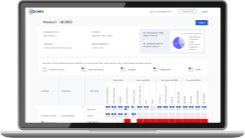
AI is no longer just a story of what's possible; it's a story of what's happening now and how we are collectively shaping the future of humanity. Across industries, organizations are no longer asking if they should adopt AI but how fast they can scale it.
At the forefront of this shift are foundational models like GPT-4o, Claude 4, and Gemini Ultra. These models are reshaping workflows, enabling multimodal interactions, and driving meaningful value across sectors like finance, healthcare, logistics, education, and content creation.
The numbers speak for themselves. According to Stanford AI Index 2025, in 2024, U.S. private AI investment soared to $109.1 billion, nearly 12 times China's $9.3 billion and 24 times the U.K.'s $4.5 billion. Generative AI alone attracted $33.9 billion globally, an 18.7% jump from the previous year. It's a signal of sustained momentum and global competition.
Enterprise adoption is moving just as fast. The same report shows that 78% of companies used AI in at least one function in 2024, up from 55% in 2023. More than ever, organizations are leveraging multiple models to run high-impact use cases, from automated support and advanced analytics to AI-generated code, simulations, and research acceleration.
But with so many AI models now available, the next question is no longer about whether to use AI. It's about choosing the right model for the right job.
This blog is your 2026 playbook. We compare the top commercial, open-source, and specialized AI models, analyzing their cost-performance tradeoffs, technical architecture, and enterprise readiness.
Whether you're a CTO evaluating options or an L&D leader building AI capability across teams, this guide gives you a clear, strategic lens on the models shaping the AI-powered future.
AI Model Ecosystem 2026
In 2026, the AI landscape will be defined by two dominant ecosystems: commercial models and open-source models. These ecosystems are shaping how businesses adopt AI, scale its use, and extract value from it. For decision-makers, understanding the differences between these two approaches is essential to building a responsible, scalable AI strategy.
1. Commercial Leaders
Commercial AI models refer to proprietary systems developed and maintained by major technology players such as OpenAI, Anthropic, and Google DeepMind:
- OpenAI’s GPT-4o powers ChatGPT Enterprise and Microsoft Copilot, offering unmatched multimodal reasoning and API reliability.
- Anthropic’s Claude 4 series is built for responsible AI adoption, known for its emphasis on safety and alignment through Constitutional AI.
- Google’s Gemini 2.5 Pro and Ultra are leading native multimodal models, enabling real-time workflows across text, code, audio, and video.
They come embedded in cloud-native platforms like Microsoft Azure, AWS Bedrock, and Google Cloud Vertex AI, making them easily accessible for deployment at scale. Their strength lies in their reliability, alignment with ethical AI principles, and the ability to handle complex, multimodal tasks attributes that make them the preferred choice in sectors such as finance, healthcare, legal services, and manufacturing.
Amazon Bedrock has seen adoption by over 10,000 organizations, many of which rely on Claude models for research, knowledge mining, and conversational AI. Google’s Gemini, integrated into Vertex AI and Workspace, is now active in industries from manufacturing to healthcare, offering domain-specific assistants and structured automation in real-time business settings.
2. Open-Source Champions
On the flip side, the open-source movement has proven it’s not just for researchers anymore. Models like Meta’s LLaMA 3, Mistral’s Mixtral and Magistral, and Falcon are being adopted by startups, digital-native enterprises, and even governments looking for transparency and adaptability.
What makes them appealing?
- Cost-efficiency without being overly stripped-down.
- Customizability for specific domains, languages, or workflows.
- Community innovation, which is accelerating fine-tuning, safety tuning, and benchmarking.
Many organizations that once defaulted to commercial APIs are now exploring open models to reduce vendor lock-in, control sensitive data flows, and optimize inference costs, especially in edge environments or AI product stacks.
Meta’s open-weight LLaMA 3 powers its assistants across Facebook, Instagram, and WhatsApp. Mistral’s fast, lightweight models are seeing adoption in industries where real-time processing and latency matter more than sheer power.
As we move forward, we’ll explore how these ecosystems break down into model families, compare them by cost vs. performance, and map their application across industries from law and logistics to life sciences.
AI Model Families and the Cost-Performance Landscape
Behind every enterprise use case is a foundational system shaped by years of training, architectural design, alignment philosophy, and performance tuning.
To simplify the landscape, today’s leading AI models fall into three logical clusters:

1. Language Models: The Core Intelligence Layer
These are the flagship large language models (LLMs) most enterprises are integrating across workflows from research to coding to customer interaction. What unites them is depth in reasoning, large context windows, and strong alignment for business use.
1. GPT‑4o (OpenAI)
- Multimodal “omni” model released May 2024, handling text, voice, vision, and audio natively
- Supports 50+ languages with a 128K token context window and advanced token compression for non-Latin scripts
- Achieves 88.7 MMLU (latest benchmark), surpassing GPT‑4’s 86.5, and operates at ~0.32s latency nearly 9× faster than GPT‑3.5
- Cheaper than GPT‑4.5 ($2.50 inbound vs. $75/million tokens), delivering real-world efficiency and cost-effectiveness
2. Claude Family (Anthropic)
- Claude Opus 4 provides 200K token context for complex document processing
- Built on Constitutional AI designed to resist misinformation proven in a study where it declined to generate false health info over half the time
- Used in AWS Bedrock by Pfizer, KT Telecom, and government agencies for secure, large-scale reasoning tasks
3. Gemini Family (Google)
- Ultra & 2.5 Pro are Google’s first native multimodal models, trained on text, code, images, audio, and video
- Gemini Ultra breaks 90% on MMLU, dominating coding and science evaluations. It powers Vertex AI and Workspace pilots across industries
4. xAI Grok 3
- Trained on ~200K GPUs, Grok 3 introduces a transparent “Think Mode” for chain-of-thought reasoning
- Scored higher than GPT‑4o in internal math/physics tests like AIME and GPQA, and achieved a 1402 Elo rating on Chatbot Arena
5. Meta LLaMA 3 (70B)
- Supports 128K-token context and multilingual input/output under Apache 2.0 license
- Powers built-in AI across Facebook, Instagram, and WhatsApp, allowing extensive fine-tuning and deployment by developers
2. Specialized & Domain Models: Purpose-Built Intelligence for Precision Tasks
While generalist LLMs dominate headlines, many of the most impactful enterprise use cases in 2026 are driven by specialized AI models, purpose-built for domains like software development, design, or biotechnology. These models are optimized for precision, latency, and domain-relevant reasoning.
1. GitHub Copilot (Codex)
- Built from a GPT-3-derived Codex model, Copilot integrates with IDEs like VSCode. Developers report up to 55% faster code completion in real-world tasks
2. DALL·E 3, Midjourney v6, Stable Diffusion XL
- DALL·E 3 provides high-fidelity images with prompt-precise control in ChatGPT and Microsoft Designer.
- Midjourney v6 dominates artistic workflows.
- Stable Diffusion XL (open-source) enables enterprise-grade, customizable image generation.
3. AlphaFold & ESMFold
- AlphaFold now provides structural data for over 200 million proteins, revolutionizing drug discovery and life sciences
- ESMFold uses transformer architecture to accelerate genomic protein modeling at scale.
4. Mistral Magistral (Small, 24B)
- Tailored for symbolic logic, Magistral delivers 10× faster self-inference compared to peers, ideal for edge and compliance-heavy applications.
3. Open-Source Innovators: Redefining AI Accessibility and Control
The open-source AI movement is not just about cost savings; it’s about transparency, fine-tuning freedom, and ecosystem acceleration. These models have gained adoption in research, regulated sectors, and resource-constrained environments.
1. Meta LLaMA 3 (Open)
- Available under Apache 2.0 license, it supports extensive fine-tuning, long contexts (128K tokens), and integration across social media platforms
2. Mistral Mixtral & Magistral
- Mixtral introduces a Mixture-of-Experts architecture for efficient, modular performance
- Magistral, focusing on logic, is fast and open-weight, gaining traction in startups and education
3. Falcon 180B (TII)
- Once the world’s largest open LLM, it supports high-context workloads and secure deployments in countries prioritizing AI sovereignty
4. Cohere Command R+
- Optimized for retrieval-augmented generation (RAG), it enhances enterprise document workflows in sectors like finance, law, and governance
Cost vs. Performance: A Critical Call When Choosing the Best AI Model
In real-world enterprise AI use cases, whether powering chatbots, copilots, document summarization, or domain-specific reasoning, token costs can scale quickly. Performance (measured via benchmark scores, accuracy, or real-world utility) must be weighed against token throughput costs to ensure ROI. Models with high accuracy but prohibitive costs might not be sustainable, while low-cost models with underwhelming results can hurt user experience and brand trust.
This graph allows organizations to:
- Benchmark model utility per dollar
- Choose the right model for cost-sensitive or latency-sensitive applications
- Determine upgrade paths based on cost-performance improvements
Data were derived from public benchmarks and performance indexes, including ModelBooth and Tismo.ai.

Top Performers with Highest ROI:
- Mixtral delivers 88% performance at just $0.225, an exceptional value, especially for startups or internal tools where cost efficiency is crucial.
- GPT-4o offers near top-tier performance (93%) at less than half the cost of traditional GPT-4 models ideal for real-time, multimodal workloads.
High-Cost High-Performance Leaders:
- Claude Opus 4 and Gemini Ultra are at the top of the performance scale (~96%) but with significantly higher costs per million tokens. Suitable for critical applications where accuracy and nuance matter more than cost.
- GPT-4 Turbo and Claude Sonnet 4 deliver a more balanced offering but still reside in the higher cost brackets.
Niche or Specialized Value:
- Claude Haiku and LLaMA 3 trail slightly in performance but are useful for targeted use cases such as open-source deployments, fine-tuning, or low-latency embedded systems.
Takeaway:
- There’s no universal “best” model. The right choice depends on your use case, budget, and deployment environment.
- Cost does not always reflect value. Mixtral and GPT-4o outperform their cost tier dramatically.
- Consider performance plateaus. Beyond a certain price point, performance gains taper off. Decision-makers must evaluate if marginal improvements justify higher costs.
- Model selection is strategic. Use premium models for customer-facing intelligence and cost-effective ones for internal tooling or experimentation.
Application Mapping by Use Case: How AI Models Power Real-World Workflows
The value of any AI model lies in how well it fits a business objective, user scenario, or operational need. In 2026, organizations are mapping AI capabilities to precise use cases, creating a modular AI stack that drives measurable impact.
To help you navigate this landscape, we’ve grouped leading AI models into six high-impact application categories. This “application-to-model” mapping is based on real-world deployments across industries.
1. Content Creation: From Words to Multimedia
AI models are powering the next generation of content workflows, from marketing copy and email drafting to video scripting and multimedia ideation.
- GPT-4o: Known for its balanced reasoning and creativity, GPT-4o is widely used for long-form content, blogs, and marketing assets within tools like Microsoft Copilot and ChatGPT Enterprise.
- Claude Sonnet 4: With its emphasis on safe, structured writing and reduced hallucination, Claude Sonnet is often preferred in regulated industries like finance or healthcare marketing.
- Gemini Pro: Thanks to native multimodal capabilities, Gemini Pro supports content creation that blends text, code snippets, and visuals for richer, more interactive outputs.
Generative AI could increase the productivity of the marketing function with a value between 5 and 15 percent of total marketing spending. -Mckinsey
2. Code Development: AI for Software Engineering
Generative AI has revolutionized coding, speeding up development lifecycles, reducing bugs, and assisting new programmers.
- GitHub Copilot: The industry standard for assisted coding, tightly integrated with Visual Studio Code and used by over 1.5 million developers.
- CodeT5 & StarCoder: Fine-tuned models for code generation, bug fixes, and documentation automation popular in enterprises needing open models or custom logic.
The direct impact of AI on the productivity of software engineering could range from 20 to 45 percent of the current annual spending on the function. -Mckinsey
3. Business Analysis & Decision Intelligence
For data-heavy roles in finance, operations, or strategy, AI models augment human decision-making through faster synthesis and insight generation.
- Claude Opus 4: With leading reasoning capabilities and long-context handling (up to 200K tokens), Claude Opus is ideal for risk analysis, compliance, and strategic reporting.
- GPT-4 Turbo: A favorite in consulting, legal, and business research tasks requiring quick turnaround and factual summarization.
- Gemini Ultra: Embedded in Google Workspace, Gemini Ultra assists with real-time document analysis, forecasting, and presentations.
By 2028, at least 15% of day-to-day work decisions will be made autonomously through agentic AI, up from zero percent in 2024. -Gartner
4. Customer Service & Experience Automation
AI chatbots and virtual assistants are reshaping how brands interact with customers, scaling support while enhancing personalization.
- Claude Haiku: Lightweight and fast, Haiku is ideal for customer service bots where low latency and conversational flow matter most.
- Gemini Nano: Optimized for edge devices, Gemini Nano powers AI assistants on mobile apps and smart devices.
- LLaMA 3: An open-source alternative for brands that prioritize cost, privacy, or in-house customization.
Research found that at one company with 5,000 customer service agents, the application of generative AI increased issue resolution by 14 percent an hour and reduced the time spent handling an issue by 9 percent. -Mckinsey
5. Research & Education: Knowledge Acceleration
AI is transforming research labs, classrooms, and corporate learning environments by enabling faster access to knowledge and deeper insights.
- GPT-4o: Used for literature review, rapid summarization, and academic research support.
- Claude Opus 4: Employed in scientific simulations, medical literature analysis, and legal case summarization.
- LLaMA 3: Favored in academic research projects and open-source communities due to its transparency and tunability.
Around half (51%) of teachers feel that the use of AI in education will have a positive impact, compared to just over a fifth (21%) who hold negative views. -AIPRM
6. Creative Arts & Design: AI for Visual Innovation
Generative AI models are enabling hyper-creative outputs for art, design, fashion, and entertainment augmenting human creativity rather than replacing it.
- DALL·E 3: Known for photorealism and creative consistency, embedded in Microsoft Designer and ChatGPT Plus.
- Midjourney v6: The go-to model for aesthetic-focused digital art, widely adopted by designers and agencies.
- Stable Diffusion XL: An open-weight favorite for customizable, local, or privacy-sensitive image generation.
Recent AI art statistics found that nearly half (45.6%) of artists feel text-to-image software will have a dramatic positive influence on creative practices. -AIPRM
Multi-Dimensional Feature Analysis
The following table highlights the key differences between some of the top AI models in use as of 2026. Each model has its strengths. Some are better at understanding complex questions, while others are more affordable or faster to use. There are also important differences in how they handle context and how safely they respond to sensitive topics.
This AI models comparison table helps give a clearer picture of which model might be the best fit for different needs.
Key Takeaways from the latest AI model comparisons
- When it comes to advanced reasoning capabilities, Claude 3 and Gemini Ultra stand out for their performance on logical and math-intensive tasks, while Grok 3 excels specifically in symbolic reasoning.
- In the multimodal space, Gemini Ultra leads as the only model trained natively across all five major data types: text, code, image, video, and audio, giving it a unique edge in handling diverse inputs.
- For long-context tasks, Claude 3 offers reliable performance with support for up to 200K tokens, whereas Gemini Ultra is capable of processing over 1 million tokens adaptively, making them well-suited for document-heavy workflows.
- For those seeking open-source flexibility, LLaMA 3 and Mistral (Magistral) are standout choices due to their speed and accessible licenses, though they slightly trail behind in complex reasoning.
- On the enterprise front, GPT-4, Claude 3/4, and Gemini are commonly chosen for industries like finance, legal, and insurance, due to their stronger alignment with safety standards and responsible deployment practices.
Technical Architecture Comparison
As AI models move from labs to real-world applications, understanding their underlying technical architectures is essential for selecting the right solution for your enterprise needs.
While many models appear similar on the surface, offering text generation, code assistance, or image understanding, their architectures, training strategies, and deployment models differ significantly. These differences impact everything from cost and scalability to accuracy, safety, and ethical alignment.
The table below summarizes the technical aspects of the top AI models in 2026.
What Makes Each Model Technically Distinct?
The “Input–Processing–Output” Lens: How Models Operate:
All AI models essentially follow an Input → Processing → Output pipeline, but how they do this varies:
- Input:
- Some models (like Gemini and GPT-4o) handle multiple input types natively (text, images, audio, code).
- Others (LLaMA, Magistral) focus on optimized text-only inputs for speed or cost efficiency.
- Processing:
- Models like Claude 4 use Constitutional AI for safer alignment.
- Gemini Ultra employs adaptive compute scaling resources in real-time for complex tasks.
- Open models like LLaMA 3 enable fine-tuning and control at the processing level.
- Output:
- Multimodal models generate diverse outputs (text, visuals, code, summaries).
- Some models prioritize safety (Claude), others emphasize creative flexibility (Grok), and some aim for maximum inference speed (Magistral).
Why Architecture Matters for Enterprises:
- Multimodal Workflows: Gemini, GPT-4o, and ERNIE are better suited for cross-media tasks (marketing, healthcare, education).
- Safety and Regulation: Claude’s Constitutional AI is a standout for industries with strict compliance needs.
- Cost vs. Control: Open-weight models like LLaMA and Magistral reduce cost but require in-house expertise.
Model Selection Framework
With dozens of AI models available in 2026, selecting the right one can feel overwhelming. The ideal choice depends on your business priorities, technical requirements, and budget constraints. To simplify decision-making, we’ve developed a Model Selection Decision Tree that maps the most popular models to common enterprise needs.
The decision-making process typically begins by asking:
What’s your top priority?
- Performance: You need the highest reasoning accuracy, long-context handling, or advanced coding/math abilities.
- Cost: You need budget-friendly or open-source models for broader accessibility or customization.

If Performance is the Priority:
1. Complex Tasks (Advanced Reasoning, Research, Legal, Scientific Work)
- Claude Opus 4: Exceptional for complex reasoning, technical content, and safety. Often chosen by legal, healthcare, and R&D teams.
2. General Use (Marketing, Customer Service, Content Creation, Office Productivity)
- GPT-4 Turbo: Reliable, fast, and highly capable for business content, customer support, and everyday AI tasks.
3. Need Multimodal?
- Yes:- GPT-4o: For text, images, and audio tasks in a unified model. Ideal for creative industries, education, and media.
- No:- Claude Sonnet 4: When text-only precision with reduced hallucination is the goal (e.g., insurance, finance).
If Cost is the Priority:
1. Open-Source Preference (Customization, Privacy, Control)
- LLaMA 3 (Meta): Best for organizations wanting to fine-tune models, control costs, or maintain on-premise AI. Widely used in research, startups, and digital innovation teams.
2. Budget-Friendly AI for Lightweight Use Cases (Chatbots, Basic Automation)
- Gemini Nano: Optimized for mobile, edge computing, and simple task automation. Excellent for companies embedding AI into existing apps or devices.
AI Adoption Roadmap: A Phased Approach to Successful Implementation
To help organizations transition from exploration to enterprise-wide value, we propose a clear 4-Phase AI Adoption Roadmap designed to guide decision-makers through every stage of implementation.
Phase 1: Assessment: Set the Foundation
Before investing in tools or technology, organizations must conduct a thorough assessment of:
- Current State: Digital maturity, data readiness, and existing AI experimentation.
- Business Needs: Identify key pain points or opportunities where AI can create measurable value (e.g., customer service automation, predictive insights, content generation).
- Risk & Compliance: Evaluate regulatory requirements, ethical considerations, and data privacy implications.
Phase 2: Pilot: Experiment Safely
Start small. Run low-risk pilots in selected business units to:
- Validate AI model choices (GPT-4o, Claude, Gemini, etc.)
- Measure impact on productivity, accuracy, or decision-making.
- Identify operational or cultural friction points.
Pilots can focus on tasks like content generation, customer support chatbots, internal knowledge search, or data summarization.
Phase 3: Scale: Build Capabilities & Expand Impact
Once early pilots show success, the next phase is scaling AI across functions. This is where people development becomes critical.
Empower Teams with Edstellar AI Training:
To fully realize AI’s value, companies must upskill their workforce. Edstellar’s instructor-led, role-specific training programs ensure that:
- Technical Teams (developers, engineers, data scientists) can build and integrate AI models effectively.
- Creative & Business Teams (designers, writers, analysts, managers) can harness AI tools for productivity, insights, and innovation.
- Leadership & Project Managers can drive responsible AI adoption aligned with strategic goals.
The following table offers the top Edstellar AI training courses for corporate upskilling:
Ultimately, AI doesn’t replace teams; it makes them sharper and more effective through targeted upskilling. Train them well.
Phase 4: Optimize: Continuous Improvement
AI adoption is not a one-time project; it’s a continuous journey. As technology evolves, organizations should:
- Continuously monitor model performance and business impact.
- Introduce new use cases (agentic AI, multimodal AI, automation).
- Refine governance, ethics, and data management practices.
Many organizations also explore AI Centers of Excellence (CoE) at this stage to drive sustained innovation.
Final Thoughts: Turning AI Potential into Business Value
In 2026, virtually every industry is exploring or actively deploying AI models, ranging from finance to healthcare and from customer service to creative design. With over 10,000 organizations worldwide piloting generative AI, the conversation has shifted from “Should we use AI?” to “How do we scale it responsibly and effectively?”
The organizations seeing the greatest returns are those that don’t treat AI as just a technology upgrade but as a strategic capability, one that is built, scaled, and continuously optimized through both the right models and the right people.
The choice of AI model, whether GPT-4 for enterprise-grade performance, Gemini for multimodal flexibility, Claude for safety, or LLaMA/Mistral for cost efficiency, ultimately depends on use-case fit, operational needs, and long-term goals.
But no model delivers value on its own. Human capability is the multiplier. That’s why organizations are increasingly turning to comprehensive upskilling solutions like Edstellar, which offers:
- 2,000+ instructor-led training programs across technical, creative, managerial, and leadership domains.
- Tailored learning pathways powered by Skill Management Software and Stellar AI to help every team member contribute to AI transformation.
- For organizations seeking to scale AI beyond pilots, the Skill Matrix provides a structured approach to building a future-ready workforce, ensuring that technology investments are matched with the right human capital.
In short:
- The right model powers your AI.
- The right people unleash its value.
- The right roadmap ensures sustainable impact.
With the right foundation, AI moves from experimental pilots to a scalable, strategic advantage, transforming not just how businesses operate but also how they grow, compete, and lead in a rapidly changing world.
Continue Reading
Explore High-impact instructor-led training for your teams.
#On-site #Virtual #GroupTraining #Customized

Bridge the Gap Between Learning & Performance
Turn Your Training Programs Into Revenue Drivers.
Schedule a ConsultationEdstellar Training Catalog
Explore 2000+ industry ready instructor-led training programs.

Coaching that Unlocks Potential
Create dynamic leaders and cohesive teams. Learn more now!


Want to evaluate your team’s skill gaps?
Do a quick Skill gap analysis with Edstellar’s Free Skill Matrix tool

Transform Your L&D Strategy Today
Unlock premium resources, tools, and frameworks designed for HR and learning professionals. Our L&D Hub gives you everything needed to elevate your organization's training approach.
Access L&D Hub Resources.svg)
.svg)



.svg)


.svg)
.svg)
.svg)
.svg)

